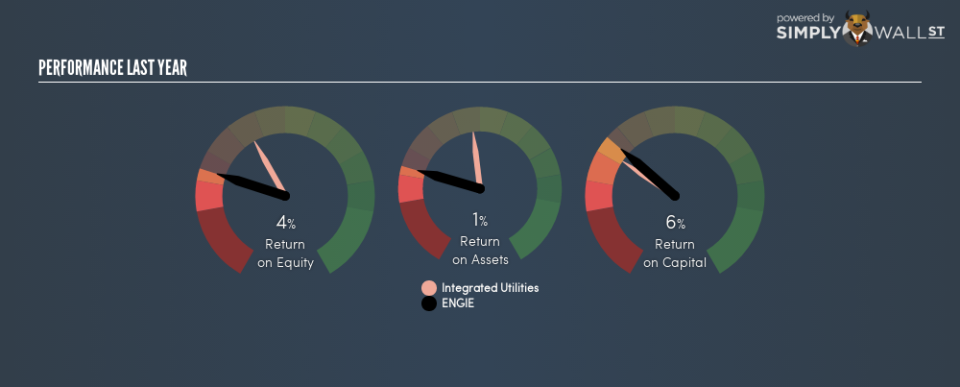Is ENGIE SA (EPA:ENGI) Creating Value For Shareholders?

Want to help shape the future of investing tools? Participate in a short research study and receive a subscription valued at $60.
Today we’ll evaluate ENGIE SA (EPA:ENGI) to determine whether it could have potential as an investment idea. Specifically, we’ll consider its Return On Capital Employed (ROCE), since that will give us an insight into how efficiently the business can generate profits from the capital it requires.
First up, we’ll look at what ROCE is and how we calculate it. Then we’ll compare its ROCE to similar companies. Last but not least, we’ll look at what impact its current liabilities have on its ROCE.
Return On Capital Employed (ROCE): What is it?
ROCE measures the amount of pre-tax profits a company can generate from the capital employed in its business. In general, businesses with a higher ROCE are usually better quality. Ultimately, it is a useful but imperfect metric. Renowned investment researcher Michael Mauboussin has suggested that a high ROCE can indicate that ‘one dollar invested in the company generates value of more than one dollar’.
So, How Do We Calculate ROCE?
The formula for calculating the return on capital employed is:
Return on Capital Employed = Earnings Before Interest and Tax (EBIT) ÷ (Total Assets – Current Liabilities)
Or for ENGIE:
0.061 = €4.7b ÷ (€151b – €56b) (Based on the trailing twelve months to June 2018.)
Therefore, ENGIE has an ROCE of 6.1%.
See our latest analysis for ENGIE
Does ENGIE Have A Good ROCE?
ROCE is commonly used for comparing the performance of similar businesses. Using our data, ENGIE’s ROCE appears to be around the 6.7% average of the Integrated Utilities industry. Setting aside the industry comparison for now, ENGIE’s ROCE is mediocre in absolute terms, considering the risk of investing in stocks versus the safety of a bank account. Readers may find more attractive investment prospects elsewhere.
Remember that this metric is backwards looking – it shows what has happened in the past, and does not accurately predict the future. Companies in cyclical industries can be difficult to understand using ROCE, as returns typically look high during boom times, and low during busts. ROCE is, after all, simply a snap shot of a single year. Since the future is so important for investors, you should check out our free report on analyst forecasts for ENGIE.
What Are Current Liabilities, And How Do They Affect ENGIE’s ROCE?
Liabilities, such as supplier bills and bank overdrafts, are referred to as current liabilities if they need to be paid within 12 months. Due to the way ROCE is calculated, a high level of current liabilities makes a company look as though it has less capital employed, and thus can (sometimes unfairly) boost the ROCE. To check the impact of this, we calculate if a company has high current liabilities relative to its total assets.
ENGIE has total assets of €151b and current liabilities of €56b. As a result, its current liabilities are equal to approximately 37% of its total assets. ENGIE’s ROCE is improved somewhat by its moderate amount of current liabilities.
What We Can Learn From ENGIE’s ROCE
Despite this, its ROCE is still mediocre, and you may find more appealing investments elsewhere. Of course you might be able to find a better stock than ENGIE. So you may wish to see this free collection of other companies that have grown earnings strongly.
I will like ENGIE better if I see some big insider buys. While we wait, check out this free list of growing companies with considerable, recent, insider buying.
To help readers see past the short term volatility of the financial market, we aim to bring you a long-term focused research analysis purely driven by fundamental data. Note that our analysis does not factor in the latest price-sensitive company announcements.
The author is an independent contributor and at the time of publication had no position in the stocks mentioned. For errors that warrant correction please contact the editor at editorial-team@simplywallst.com.

